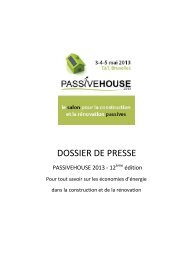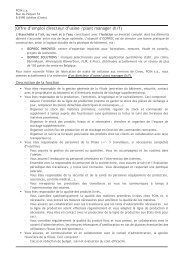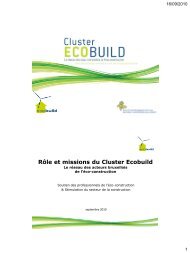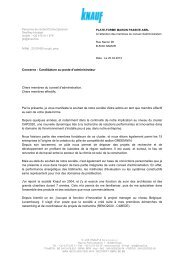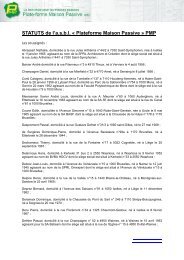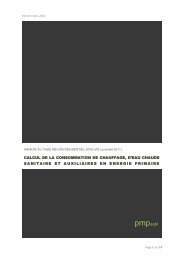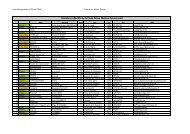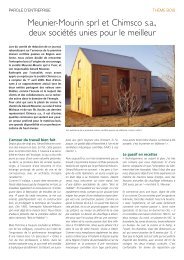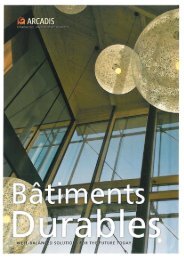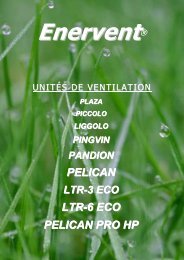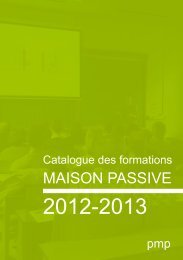Micronal PCM - Plate-forme Maison Passive
Micronal PCM - Plate-forme Maison Passive
Micronal PCM - Plate-forme Maison Passive
- No tags were found...
Create successful ePaper yourself
Turn your PDF publications into a flip-book with our unique Google optimized e-Paper software.
A broader base for your successPolymer Dispersions for:ConstructionArchitectural CoatingsAdhesivesFiber Bonding<strong>Micronal</strong> ® <strong>PCM</strong>Intelligent TemperatureManagement for Buildingswww.micronal.de
2 <strong>Micronal</strong> ® <strong>PCM</strong> Intelligent Temperature Management for Buildings<strong>Micronal</strong> ® <strong>PCM</strong>Intelligent Temperature Managementfor BuildingsThe Challenge:The indoor temperature is signifi cantly infl uenced by thethermal behaviour of a building. In buildings, which becauseof their construction method lack the required thermalstorage mass, inner loads and sun radiation lead to greatfl uctuations in temperature, losses of comfort and increasedneed for air conditioning inside buildings.Nowadays, construction of offi ces and housing is increasinglycarried out using modern lightweight building methodsof wood and steel designs with highly insulating wall constructionmaterials and large glass surfaces. The highdegree of prefabrication and the avoidance of long dryingtimes lead to quick progress in construction and thus anespecially high level of effi ciency. In striving to optimise themass and dematerialisation of the building components, inaddition to various practical and economic advantages, oneproblem, namely a loss of thermal mass and the negativeimpacts on the indoor climate arises.<strong>Micronal</strong> ® <strong>PCM</strong> – Future built inCompliance with the relevant construction guidelines governing climate policy, along with international efforts in buildingcertifi cation in terms of indoor climate, comfort, health, use of resources and energy effi ciency, make clear the highdemands on architecture, building planning and construction. The consequence – the necessity of developing new,innovative and sustainable approaches for the construction industry, in order to deal with these challenges and to fulfi lthe exacting demands. With <strong>Micronal</strong> ® <strong>PCM</strong> BASF has developed an innovative latent heat storage material, whichmakes the construction industry sustainable in the area of air conditioning in buildings. <strong>Micronal</strong> ® <strong>PCM</strong> is an innovative,long-term and sustainable solution for a pleasant, healthy indoor climate and more energy effi cient air conditioning; formodern architecture with high demands – today and in the future.
3 <strong>Micronal</strong> ® <strong>PCM</strong> Intelligent Temperature Management for Buildings<strong>PCM</strong> cleverly packedThe Solution:<strong>Micronal</strong> <strong>PCM</strong> ® , BASF’s formaldehyde-free microencapsulatedlatent heat storer makes it possible to combine theadvantages of modern architecture and the effi ciency oflightweight construction with the use and compensatingeffect of thermal storage capacity for a pleasant indoorclimate .<strong>Micronal</strong> <strong>PCM</strong> ® (Phase Change Material) presents a durableand effi cient possibility for isothermal storage of the peakloads, which usually occur during the day, in a defi ned temperaturerange, and releasing these again with a time delay(e.g.: in the evening time or at night). Integrated into variouskinds of building materials and building systems, <strong>Micronal</strong> ®<strong>PCM</strong> contributes to an improved indoor climate, more comfortableliving conditions and better energy effi ciency, usingintelligent temperature management.Temperature management in thedefined comfort zoneDayTemperatureNightTime/days 1 2 3 4without<strong>Micronal</strong> ® <strong>PCM</strong>with<strong>Micronal</strong> ® <strong>PCM</strong>comfort zoneAdvantages of <strong>Micronal</strong> ® <strong>PCM</strong> at a GlanceOptimum indoor climate und consistent temperatures throughout the yearWorking and living in a comfortable and healthy temperature zone, that is between 21°C and 26°CA bonus for health: quiet air conditioning without the occurrence of draughts and transference of noiseGreater energy efficiency through better energy management. Avoidance of excessive energy consumptionand better use of sustainable sources of heat and coldYour contribution to CO 2 reduction and protection of the environment and climateHighly flexible configuration and the simplest processing with respect to conventional building materials –with a new distinctive functionality!Cost efficiency. No operating and maintenance costs, independent functionMore thermal mass in the same space, i.e. more useful surface for a given area
4 <strong>Micronal</strong> ® <strong>PCM</strong> Intelligent Temperature Management for Buildings<strong>Micronal</strong> ® <strong>PCM</strong> – High Tech in Microcapsules<strong>Micronal</strong> ® <strong>PCM</strong> is a phase change material, which completesa phase change from solid to liquid within the indoortemperature and human comfort range, i.e. at 21°C, 23°Cor 26°C and in doing so can store a large quantity of heat.This principle of latent heat storage is comparable to an icecube, which during its melting process keeps a drink at aconstant temperature of 0°C. <strong>Micronal</strong> ® <strong>PCM</strong> uses this simplephysical effect to achieve the objective of stabilising indoortemperature.<strong>Micronal</strong> ® contains in the core of the microcapsule (sizearound 5 μm) a latent heat storage material made from aspecial wax mixture. When there is a rise in temperatureabove a defi ned temperature threshold (21°C, 23°C or26°C), this absorbs the excessive heat energy and storesit in phase change. When the temperature falls below thetemperature threshold, the capsule releases this stored heatenergy again. 1TEMPERATUREPhase Change inside the CapsulesolidPolymer5 μmTm:21/23/26 ˚CliquidWaxMELTING/SOLIDIFICATIONENERGY ABSORPTION/ENERGY RELEASEsolidWhilst the latent heat is generally stored autonomouslyabove a defi ned temperature from heat inputs occurringduring the day, discharge of the storage material canoccur via natural ventilation, mechanical ventilation oralso via sustainable or conventional cooling concepts.COOL HOT COOLSURROUNDINGSThe Advantages of MicroencapsulationSealed packaging, the product always stays dryThe phase change is not visible externally, the change in volume in the melting process occurs in each capsule.<strong>PCM</strong> building materials therefore remain stable in terms of size.Tiny volumes and tiny space requirements with high heat storage capacity.“Just in Time”. Rapid heat exchange through high surface / volume ratio. 1g <strong>Micronal</strong> ® <strong>PCM</strong> = 30m² surfaceCan be directly integrated into the building material, i.e. can be used without additional work processes orhigher complexity on the construction siteMechanically, practically indestructible, high cycle resistance and functions over decadesFormaldehyde-free1With this process, the aggregate state of the storage material changes: the temperature of the system therefore remains almost constant,as long as the whole concealed = latent heat is absorbed or released.
5 <strong>Micronal</strong> ® <strong>PCM</strong> Intelligent Temperature Management for BuildingsThe <strong>Micronal</strong> ® <strong>PCM</strong> Product Portfolio<strong>Micronal</strong> ® <strong>PCM</strong> can be incorporated into building materialsin different forms. For all applications in which a liquid formcan be used, BASF offers <strong>Micronal</strong> ® <strong>PCM</strong> dispersions, inwhich the microcapsules are dispersed in water. For buildingapplications which require a powder form (such as dryblends like plaster or cement mortar for example), BASFoffers a portfolio of redispersible powders.<strong>Micronal</strong> ® <strong>PCM</strong> – as dispersion and powderProductdesignationProducttypeMelting pointapprox.ApplicationIntegrationrangeOverall storagecapacity approx.Latent heat capacityapprox.SolidcontentDensityApparentdensityViscosityDS 5000 Dispersion 26°C Summertime excessive heating protection 10–30˚C 59 kJ/kg 45 kJ/kg Approx 42% Approx0,98Approx200–600 mPasDS 5007 Dispersion 23°CStabilisation of the indoor temperaturein the comfort zone<strong>Passive</strong> and active application10–30˚C 55 kJ/kg 41 kJ/kg Approx 42% Approx0,98Approx200–600 mPasDS 5030 Dispersion 21°C Surface cooling systems 10–30˚C 51 kJ/kg 37 kJ/kg Approx 42% Approx0,98Approx200–600 mPasDS 5001 Pulver 26°C Summertime excessive heating protection 10–30˚C 145 kJ/kg 110 kJ/kgIn powderformApprox250–350 kg/m 3DS 5008 Pulver 23°CStabilisation of the indoor temperaturein the comfort zone<strong>Passive</strong> and active application10–30˚C 135 kJ/kg 100 kJ/kgIn powderformApprox250–350 kg/m 3DS 5029 Pulver 21°C Surface cooling systems 10–30˚C 125 kJ/kg 90 kJ/kgIn powderformApprox250–350 kg/m 3Best results can be achieved with <strong>Micronal</strong> ® <strong>PCM</strong> latent heat storers with regard to passive overheating protection,stabilisation of indoor temperatures and effi cient use of surface cooling systems, as a component part of a functionalbuilding concept.The Right Choice of Melting PointDid you know:30 kg of <strong>Micronal</strong> ® <strong>PCM</strong> gives around1 kWh of storage performance. Thiscorresponds to the quantity of heat froma 1,000 W hairdryer running for 1 hour.26232126°C for summertime excessive heating protection(e.g.: in lofts or for passive application in warmregions )23°C for stabilisation of the indoor temperature inthe comfort zone, thus frequent use of the <strong>PCM</strong>effect . Most important product for cases of activeand passive applications.21°C for use in surface cooling systems˚C
6 <strong>Micronal</strong> ® <strong>PCM</strong> Intelligent Temperature Management for BuildingsConstruction Applications and Systemswith <strong>Micronal</strong> ® <strong>PCM</strong>Knauf Gips KG’s <strong>PCM</strong> SmartBoard ®In the form of the gypsum wallboard, Knauf <strong>PCM</strong> Smart-Board ® , <strong>Micronal</strong> ® <strong>PCM</strong> can be quickly and simply integratedinto innovative building concepts in dry construction.Every square meter of this building material contains threekilograms of the <strong>Micronal</strong> ® <strong>PCM</strong> latent heat storer. The heatcapacity of a wall construction, twice equiped with 15mm<strong>PCM</strong> SmartBoard ® , is thus comparable to a 14 cm thickconcrete wall or a 36,5 cm thick brick wall.Ilkazell Isoliertechnik GmbH’s Ilkatherm ® SystemDerived from sandwich technology (metal surface, PURrigid foam core, metal surface), highly effi cient radiantceiling panels with <strong>Micronal</strong> ® <strong>PCM</strong> were developed, whichcan be linked to existing cooling water circuits via a simplePlug and Play process. Water cooling is achieved throughcapillary tube mats, which are located on the reverse ofthe <strong>PCM</strong> layer facing into the room. This system solutionmakes renewable cooling and buffering of peak loadspossible .© Ilkazell Isoliertechnik GmbH<strong>Passive</strong> or Active ApplicationWith <strong>Micronal</strong> ® <strong>PCM</strong>, modifi ed building materials can be used in “passive application”, i.e. without simultaneous useof mechanical cooling, but also as a component of an “activated” system in building concepts. An activated systemdescribes the combination of various components, which enable recooling or active charging or discharging of thestorage material. The heat transfer medium for this can for example be air or water.
7 <strong>Micronal</strong> ® <strong>PCM</strong> Intelligent Temperature Management for BuildingsMaxit clima ® machine-applied plaster frommaxit Deutschland GmbHMaxit clima is a <strong>PCM</strong> machine-applied plaster for makingsingle-layer interior plaster with a temperature regulatingeffect . Through varying the thickness of the layer, the quantityof <strong>Micronal</strong> ® <strong>PCM</strong> latent heat storer can be con trolledaccording to requirements. Maxit clima ® is available fullyformulated (for direct processing on the construction site)as a dry mortar.H+H Deutschland GmbH’s CelBloc Plus ®The green aerated concrete CelBloc Plus offers the capabilityfor latent heat storage in addition to good heat, fi reand sound insulation characteristics and positive environmentallycompatible characteristics for adjusting airhumidity .The migration of the heat front through the outer wall isslowed down by the active <strong>PCM</strong> component. The result isa highly insulating stone that shows smaller temperaturefl uctuations on the inner wall surface for the same U-value.This leads to more constant indoor temperatures.© H+H Deutschland GmbHFurther product developments on request.Tips for Planners<strong>Micronal</strong> ® <strong>PCM</strong> has demonstrated its performance in accordance with the criteria of the RALquality control association, Gütegemeinschaft <strong>PCM</strong> e.V, in comprehensive test series. <strong>Micronal</strong> ®<strong>PCM</strong> has passed all tests, both as a raw material and also in <strong>PCM</strong> SmartBoard ® dry wallboards,and has had the RAL quality mark since 22 August 2008. Thus invitations to tender accordingto RAL-GZ 896 for building products based on <strong>Micronal</strong> ® <strong>PCM</strong> correspond to goodprofessional practice and the recognised technological rules.Details can be found at www.pcm-ral.de
8 <strong>Micronal</strong> ® <strong>PCM</strong> Intelligent Temperature Management for Buildings<strong>Micronal</strong> ® <strong>PCM</strong> – High Performancein Intelligent Building ConceptsThe <strong>PCM</strong>express Simulation SoftwareThe <strong>PCM</strong>express program was developed within theframework of a research project in co-operation with theFraunhofer Institute for Solar Energy Technology (ISE) inFreiburg, the Valentin Energiesoftware Company and otherindustrial partners. <strong>PCM</strong>express is a planning and simulationprogram for buildings with phase change materials(<strong>PCM</strong>). It is designed to support architects and planners inthe evaluation of the effect of <strong>PCM</strong> in concrete buildings,by enabling secure decision making for the sizing of theoverall system. As a concluding presentation, amongstother things, project reports were offered to customersand planners, as well as meaningful graphs for comparingthe systems.© Dr. Valentin EnergieSoftware GmbHReference Items with <strong>Micronal</strong> ® <strong>PCM</strong>In the past few years <strong>Micronal</strong> ® <strong>PCM</strong> has been sampled and tested several times in real reference items. Threeexamples follow from the areas of commercial construction, school construction and housing construction.<strong>PCM</strong> evaluation made easyMore about the free simulation software<strong>PCM</strong>express along with the download linkcan be found at www.micronal.de
9 <strong>Micronal</strong> ® <strong>PCM</strong> Intelligent Temperature Management for BuildingsReference Item 1: Commercial ConstructionObjective: Optimised energy concept with excellentindoor climate conditions for staffConstruction item: Offi ce construction forEngelhardt & Bauer in KarlsruheApplication: active cooling ceiling elements withrenewable cooling sources (geothermal probes)Product: Ilkazell’s Ilkatherm chilled ceiling panelConcept and monitoring: Fraunhofer Institute forSolar Energy Technology (ISE) in FreiburgResult: Geothermal probes as renewable cool sourcesconstantly provide cold energy for the Ilkatherm coolingceiling. In addition, automatic window opening controlsnight ventilation to discharge the building at night.<strong>Micronal</strong> ® <strong>PCM</strong> acts as a temporary storer for the peakloads occurring during the usage time in the day andthus homogenises the “just-in-time” cooling requirement.Reference Item: Engelhardt & BauerSmall geothermal probes are the cooling sourcesEnergy effi cient solution based on sustainablecooling conceptExhaust airNo heat exchange between the cooling source<strong>PCM</strong> chilled ceiling paneland the chilled ceiling panelMinimal technical effort expended, smalloperating and investment costsNight airDaytime coolingusing radiationexchangeNight airCooling performanceof20 kW at 16ºCUnder floor heating with waste heat from production
10 <strong>Micronal</strong> ® <strong>PCM</strong> Intelligent Temperature Management for BuildingsReference Item 2: Housing ConstructionObjective: Most constant indoor temperature possibleat 23°C, autarkic supply via photovoltaicsConstruction item: German contribution to the SolarDecathlon Competition of the DOE in Washington D.C.2008Concept: Professor Hegger, Darmstadt TechnicalUniversityApplication: passive temperature management at 23°Con walls and active cooling ceilingsProducts: Knauf <strong>PCM</strong> SmartBoard ® and Ilkathermcooling ceiling panelsConstruction methods: wood-framed lightweightconstruction , partly with vacuum insulation, interiorfi ttings dry constructionImplementation: student work group withProfessor Hegger, Darmstadt Technical UniversityWebsite: www.solardecathlon.deReference Item: Solar Decathlon House© Darmstadt TU
11 <strong>Micronal</strong> ® <strong>PCM</strong> Intelligent Temperature Management for BuildingsReference Item 3: School ConstructionObjective: Good thermal comfort in containerlightweight construction without active cooling.Construction item: new school building for the state ofLuxembourg, town of DiekirchConcept: Public Buildings Administration, new buildingsdivision, LuxembourgApplication: purely passive temperature managementat 23°C on walls and ceilingsProduct: Knauf <strong>PCM</strong> SmartBoard ®Construction methods: structural work steel containerconstruction, interior work dry construction and <strong>PCM</strong>grid ceilingsImplementation: ALHO Systembau GmbH, MorsbachMonitoring: Fraunhofer Institute for Solar EnergyTechnology (ISE) in FreiburgReference Item: School Building DiekirchFurther reference items are to be found atwww.micronal.de<strong>Micronal</strong> ® <strong>PCM</strong> was developed withhelpful support from the BMWi (FederalMinistry of Economics and Technology)under funding references: 0329840 and0327370
EDK B 0818e ® = registered trademark of BASF SEBASF SEBusiness Management <strong>Micronal</strong> ® <strong>PCM</strong>Marketing Polymer Dispersions for Construction67056 Ludwigshafen, Germanywww.micronal.deE-mail: micronal@basf.comFor further information please contact us on ourtoll-free numbers and you will automatically betransferred to your regional contact person:Phone: 00 800 - 227 66 257 or 00 800 - ACRONALSPhone: 00 800 - 227 66 259 or 00 800 - ACRONALXThe data contained in this publication are based on our current knowledge and experience. They do not constitute the agreed contractual quality of the product and, in view of the many factors thatmay affect processing and application of our products, do not relieve processors from carrying out their own investigations and tests. The agreed contractual quality of the product at the time of transferof risk is based solely on the data in the specifi cation data sheet. Any descriptions, drawings, photographs, data, proportions, weights, etc. given in this publication may change without prior information.It is the responsibility of the recipient of our product to ensure that any proprietary rights and existing laws and legislation are observed (11/2008).



